2010 AHA 心肺复苏指南(实用中文版)
- 格式:pdf
- 大小:1.13 MB
- 文档页数:83

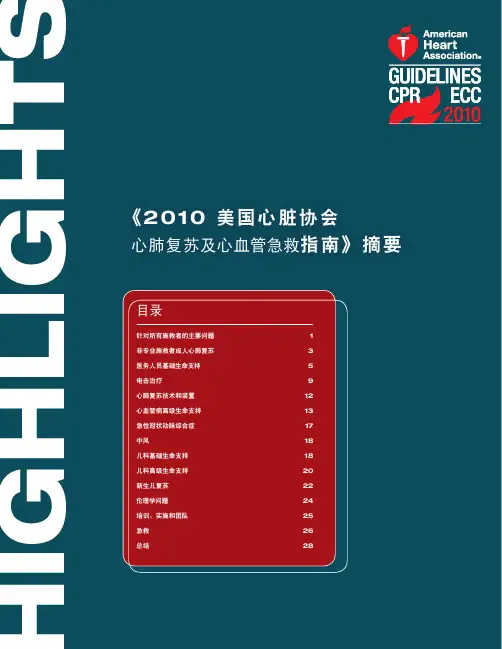
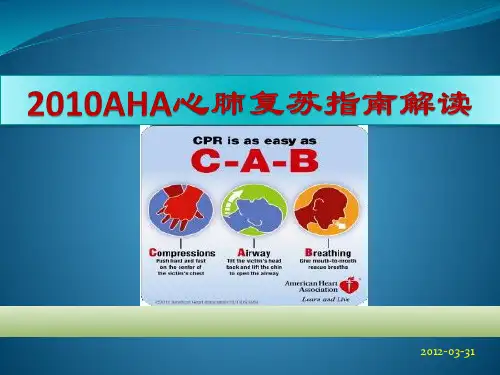
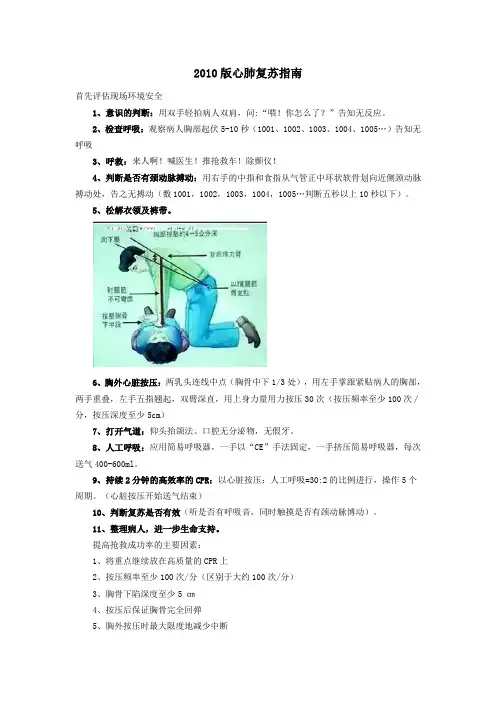
2010版心肺复苏指南首先评估现场环境安全1、意识的判断:用双手轻拍病人双肩,问:“喂!你怎么了?”告知无反应。
2、检查呼吸:观察病人胸部起伏5-10秒(1001、1002、1003、1004、1005…)告知无呼吸3、呼救:来人啊!喊医生!推抢救车!除颤仪!4、判断是否有颈动脉搏动:用右手的中指和食指从气管正中环状软骨划向近侧颈动脉搏动处,告之无搏动(数1001,1002,1003,1004,1005…判断五秒以上10秒以下)。
5、松解衣领及裤带。
6、胸外心脏按压:两乳头连线中点(胸骨中下1/3处),用左手掌跟紧贴病人的胸部,两手重叠,左手五指翘起,双臂深直,用上身力量用力按压30次(按压频率至少100次∕分,按压深度至少5cm)7、打开气道:仰头抬颌法。
口腔无分泌物,无假牙。
8、人工呼吸:应用简易呼吸器,一手以“CE”手法固定,一手挤压简易呼吸器,每次送气400-600ml。
9、持续2分钟的高效率的CPR:以心脏按压:人工呼吸=30:2的比例进行,操作5个周期。
(心脏按压开始送气结束)10、判断复苏是否有效(听是否有呼吸音,同时触摸是否有颈动脉博动)。
11、整理病人,进一步生命支持。
提高抢救成功率的主要因素:1、将重点继续放在高质量的CPR上2、按压频率至少100次/分(区别于大约100次/分)3、胸骨下陷深度至少5 ㎝4、按压后保证胸骨完全回弹5、胸外按压时最大限度地减少中断6、避免过度通气心肺复苏 = (清理呼吸道) + 人工呼吸 + 胸外按压 + 后续的专业用药据美国近年统计,每年心血管病人死亡数达百万人,约占总死亡病因1/2。
而因心脏停搏突然死亡者60-70%发生在院前。
因此,美国成年人中约有85%的人有兴趣参加CPR初步训练,结果使40%心脏骤停者复苏成功,每年抢救了约20万人的生命。
心脏跳动停止者,如在4分钟内实施初步的CPR,在8分钟内由专业人员进一步心脏救生,死而复生的可能性最大,因此时间就是生命,速度是关键,初步的CPR按ABC进行。
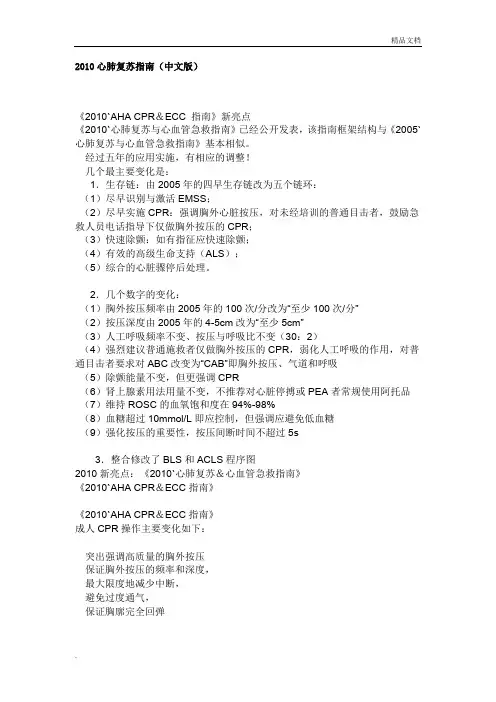
2010心肺复苏指南(中文版)《2010`AHA CPR&ECC 指南》新亮点《2010`心肺复苏与心血管急救指南》已经公开发表,该指南框架结构与《2005`心肺复苏与心血管急救指南》基本相似。
经过五年的应用实施,有相应的调整!几个最主要变化是:1.生存链:由2005年的四早生存链改为五个链环:(1)尽早识别与激活EMSS;(2)尽早实施CPR:强调胸外心脏按压,对未经培训的普通目击者,鼓励急救人员电话指导下仅做胸外按压的CPR;(3)快速除颤:如有指征应快速除颤;(4)有效的高级生命支持(ALS);(5)综合的心脏骤停后处理。
2.几个数字的变化:(1)胸外按压频率由2005年的100次/分改为“至少100次/分”(2)按压深度由2005年的4-5cm改为“至少5cm”(3)人工呼吸频率不变、按压与呼吸比不变(30:2)(4)强烈建议普通施救者仅做胸外按压的CPR,弱化人工呼吸的作用,对普通目击者要求对ABC改变为“CAB”即胸外按压、气道和呼吸(5)除颤能量不变,但更强调CPR(6)肾上腺素用法用量不变,不推荐对心脏停搏或PEA者常规使用阿托品(7)维持ROSC的血氧饱和度在94%-98%(8)血糖超过10mmol/L即应控制,但强调应避免低血糖(9)强化按压的重要性,按压间断时间不超过5s3.整合修改了BLS和ACLS程序图2010新亮点:《2010`心肺复苏&心血管急救指南》《2010`AHA CPR&ECC指南》《2010`AHA CPR&ECC指南》成人CPR操作主要变化如下:突出强调高质量的胸外按压保证胸外按压的频率和深度,最大限度地减少中断,避免过度通气,保证胸廓完全回弹提高抢救成功率的主要因素1、将重点继续放在高质量的CPR上2、按压频率至少100次/分(区别于大约100次/分)3、胸骨下陷深度至少5 ㎝4、按压后保证胸骨完全回弹5、胸外按压时最大限度地减少中断6、避免过度通气CPR操作顺序的变化:A-B-C→→C-A-B★2010(新):C-A-B即:C胸外按压→A开放气道→B人工呼吸●2005(旧):A-B-C即:A开放气道→B人工呼吸→C胸外按压生存链的变化★2010(新):1、立即识别心脏骤停,激活急救系统2、尽早实施CPR,突出胸外按压3、快速除颤4、有效地高级生命支持5、综合的心脏骤停后治疗●2005(旧):1、早期识别,激活EMSS2、早期CPR3、早期除颤4、早期高级生命支持(ACLS)应及时识别无反应征象,立即呼激活应急救援系统。
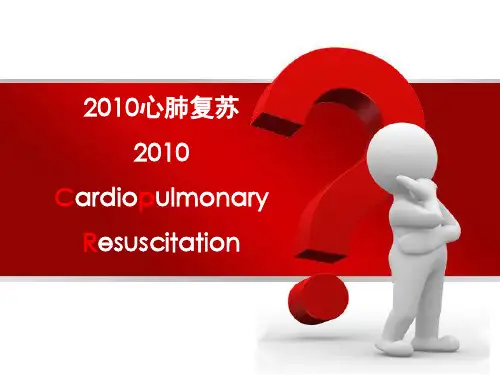
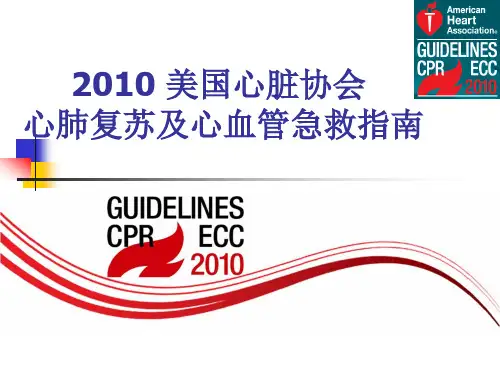
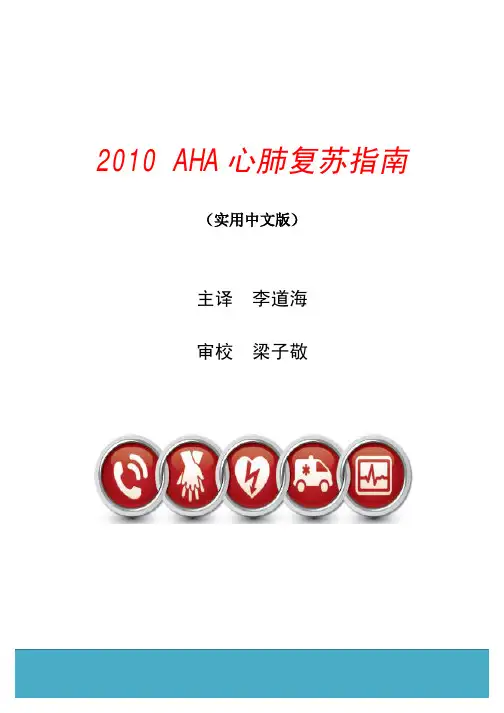
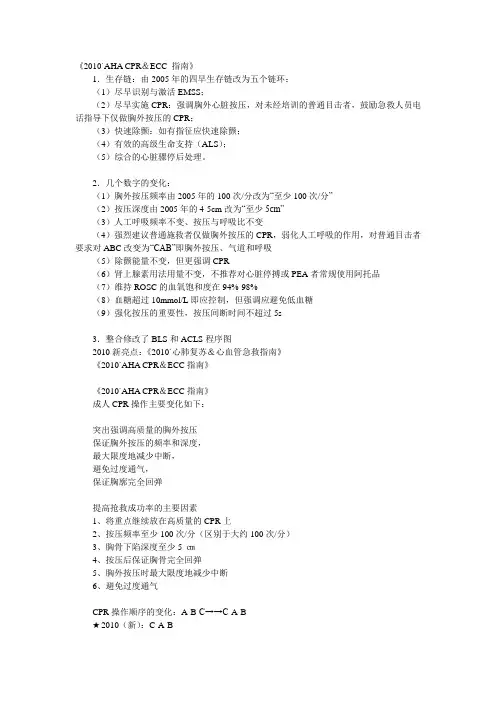
《2010`AHA CPR&ECC 指南》1.生存链:由2005年的四早生存链改为五个链环:(1)尽早识别与激活EMSS;(2)尽早实施CPR:强调胸外心脏按压,对未经培训的普通目击者,鼓励急救人员电话指导下仅做胸外按压的CPR;(3)快速除颤:如有指征应快速除颤;(4)有效的高级生命支持(ALS);(5)综合的心脏骤停后处理。
2.几个数字的变化:(1)胸外按压频率由2005年的100次/分改为“至少100次/分”(2)按压深度由2005年的4-5cm改为“至少5cm”(3)人工呼吸频率不变、按压与呼吸比不变(4)强烈建议普通施救者仅做胸外按压的CPR,弱化人工呼吸的作用,对普通目击者要求对ABC改变为“CAB”即胸外按压、气道和呼吸(5)除颤能量不变,但更强调CPR(6)肾上腺素用法用量不变,不推荐对心脏停搏或PEA者常规使用阿托品(7)维持ROSC的血氧饱和度在94%-98%(8)血糖超过10mmol/L即应控制,但强调应避免低血糖(9)强化按压的重要性,按压间断时间不超过5s3.整合修改了BLS和ACLS程序图2010新亮点:《2010`心肺复苏&心血管急救指南》《2010`AHA CPR&ECC指南》《2010`AHA CPR&ECC指南》成人CPR操作主要变化如下:突出强调高质量的胸外按压保证胸外按压的频率和深度,最大限度地减少中断,避免过度通气,保证胸廓完全回弹提高抢救成功率的主要因素1、将重点继续放在高质量的CPR上2、按压频率至少100次/分(区别于大约100次/分)3、胸骨下陷深度至少5 ㎝4、按压后保证胸骨完全回弹5、胸外按压时最大限度地减少中断6、避免过度通气CPR操作顺序的变化:A-B-C→→C-A-B★2010(新):C-A-B即:C胸外按压→A开放气道→B人工呼吸●2005(旧):A-B-C即:A开放气道→B人工呼吸→C胸外按压生存链的变化★2010(新):1、立即识别心脏骤停,激活急救系统2、尽早实施CPR,突出胸外按压3、快速除颤4、有效地高级生命支持5、综合的心脏骤停后治疗●2005(旧):1、早期识别,激活EMSS2、早期CPR3、早期除颤4、早期高级生命支持(ACLS)应及时识别无反应征象,立即呼激活应急救援系统。
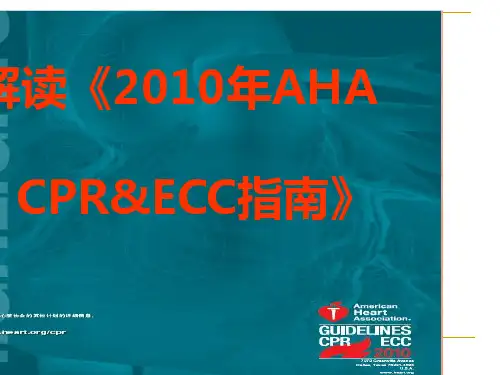
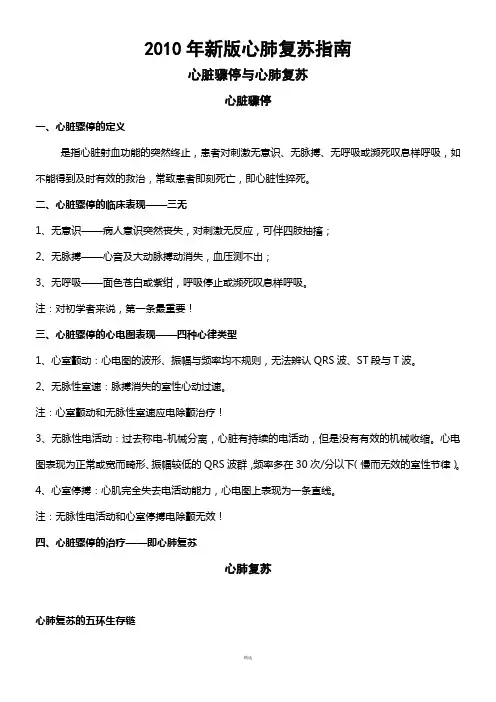
2010年新版心肺复苏指南心脏骤停与心肺复苏心脏骤停一、心脏骤停的定义是指心脏射血功能的突然终止,患者对刺激无意识、无脉搏、无呼吸或濒死叹息样呼吸,如不能得到及时有效的救治,常致患者即刻死亡,即心脏性猝死。
二、心脏骤停的临床表现——三无1、无意识——病人意识突然丧失,对刺激无反应,可伴四肢抽搐;2、无脉搏——心音及大动脉搏动消失,血压测不出;3、无呼吸——面色苍白或紫绀,呼吸停止或濒死叹息样呼吸。
注:对初学者来说,第一条最重要!三、心脏骤停的心电图表现——四种心律类型1、心室颤动:心电图的波形、振幅与频率均不规则,无法辨认QRS波、ST段与T波。
2、无脉性室速:脉搏消失的室性心动过速。
注:心室颤动和无脉性室速应电除颤治疗!3、无脉性电活动:过去称电-机械分离,心脏有持续的电活动,但是没有有效的机械收缩。
心电图表现为正常或宽而畸形、振幅较低的QRS波群,频率多在30次/分以下(慢而无效的室性节律)。
4、心室停搏:心肌完全失去电活动能力,心电图上表现为一条直线。
注:无脉性电活动和心室停搏电除颤无效!四、心脏骤停的治疗——即心肺复苏心肺复苏心肺复苏的五环生存链心肺复苏:是指对早期心跳呼吸骤停的患者,通过采取人工循环、人工呼吸、电除颤等方法帮助其恢复自主心跳和呼吸;它包括三个环节:基本生命支持、高级生命支持、心脏骤停后的综合管理。
《2010 美国心脏协会心肺复苏及心血管急救指南》将心脏骤停患者的生存链由2005年的四早生存链改为五个链环:一、早期识别与呼叫二、早期心肺复苏三、早期除颤/复律四、早期有效的高级生命支持五、新增环节——心脏骤停后的综合管理一、早期识别与呼叫(一)心脏骤停的识别——三无1、无意识判断方法:轻轻摇动患者双肩,高声呼喊“喂,你怎么了?”如认识,可直呼其姓名,如无反应,说明意识丧失。
2、无脉搏判断方法:用食指及中指指尖先触及气管正中部位,然后向旁滑移2-3cm,在胸锁乳突肌内侧触摸颈动脉是否有搏动。
ISSN: 1524-4539Copyright © 2010 American Heart Association. All rights reserved. Print ISSN: 0009-7322. Online72514Circulation is published by the American Heart Association. 7272 Greenville Avenue, Dallas, TXDOI: 10.1161/CIRCULATIONAHA.110.9708892010;122;S640-S656Circulation HoekCallaway, Brett Cucchiara, Jeffrey D. Ferguson, Thomas D. Rea and Terry L. VandenMark S. Link, Laurie J. Morrison, Robert E. O'Connor, Michael Shuster, Clifton W. Marc D. Berg, John E. Billi, Brian Eigel, Robert W. Hickey, Monica E. Kleinman,Neumar, Mary Ann Peberdy, Jeffrey M. Perlman, Elizabeth Sinz, Andrew H. Travers, Farhan Bhanji, Diana M. Cave, Edward C. Jauch, Peter J. Kudenchuk, Robert W.Schexnayder, Robin Hemphill, Ricardo A. Samson, John Kattwinkel, Robert A. Berg, John M. Field, Mary Fran Hazinski, Michael R. Sayre, Leon Chameides, Stephen M. Cardiopulmonary Resuscitation and Emergency Cardiovascular Care Part 1: Executive Summary: 2010 American Heart Association Guidelines for/cgi/content/full/122/18_suppl_3/S640located on the World Wide Web at:The online version of this article, along with updated information and services, is/reprints Reprints: Information about reprints can be found online atjournalpermissions@ 410-528-8550. E-mail:Fax:Kluwer Health, 351 West Camden Street, Baltimore, MD 21202-2436. Phone: 410-528-4050. Permissions: Permissions & Rights Desk, Lippincott Williams & Wilkins, a division of Wolters/subscriptions/Subscriptions: Information about subscribing to Circulation is online atPart1:Executive Summary2010American Heart Association Guidelines for Cardiopulmonary Resuscitation and Emergency Cardiovascular Care John M.Field,Co-Chair*;Mary Fran Hazinski,Co-Chair*;Michael R.Sayre;Leon Chameides; Stephen M.Schexnayder;Robin Hemphill;Ricardo A.Samson;John Kattwinkel;Robert A.Berg;Farhan Bhanji;Diana M.Cave;Edward C.Jauch;Peter J.Kudenchuk;Robert W.Neumar;Mary Ann Peberdy;Jeffrey M.Perlman;Elizabeth Sinz;Andrew H.Travers;Marc D.Berg; John E.Billi;Brian Eigel;Robert W.Hickey;Monica E.Kleinman;Mark S.Link;Laurie J.Morrison; Robert E.O’Connor;Michael Shuster;Clifton W.Callaway;Brett Cucchiara;Jeffrey D.Ferguson;Thomas D.Rea;Terry L.Vanden HoekT he publication of the2010American Heart Association Guidelines for Cardiopulmonary Resuscitation and Emergency Cardiovascular Care marks the50th anniversary of modern CPR.In1960Kouwenhoven,Knickerbocker,and Jude documented14patients who survived cardiac arrest with the application of closed chest cardiac massage.1That same year,at the meeting of the Maryland Medical Society in Ocean City,MD,the combination of chest compressions and rescue breathing was introduced.2Two years later,in1962, direct-current,monophasic waveform defibrillation was de-scribed.3In1966the American Heart Association(AHA) developed the first cardiopulmonary resuscitation(CPR) guidelines,which have been followed by periodic updates.4 During the past50years the fundamentals of early recogni-tion and activation,early CPR,early defibrillation,and early access to emergency medical care have saved hundreds of thousands of lives around the world.These lives demonstrate the importance of resuscitation research and clinical transla-tion and are cause to celebrate this50th anniversary of CPR. Challenges remain if we are to fulfill the potential offered by the pioneer resuscitation scientists.We know that there is a striking disparity in survival outcomes from cardiac arrest across systems of care,with some systems reporting5-fold higher survival rates than others.5–9Although technology, such as that incorporated in automated external defibrillators (AEDs),has contributed to increased survival from cardiac arrest,no initial intervention can be delivered to the victim of cardiac arrest unless bystanders are ready,willing,and able to act.Moreover,to be successful,the actions of bystanders and other care providers must occur within a system that coordi-nates and integrates each facet of care into a comprehensive whole,focusing on survival to discharge from the hospital.This executive summary highlights the major changes and most provocative recommendations in the2010AHA Guide-lines for CPR and Emergency Cardiovascular Care(ECC). The scientists and healthcare providers participating in a comprehensive evidence evaluation process analyzed the sequence and priorities of the steps of CPR in light of current scientific advances to identify factors with the greatest potential impact on survival.On the basis of the strength of the available evidence,they developed recommendations to support the interventions that showed the most promise. There was unanimous support for continued emphasis on high-quality CPR,with compressions of adequate rate and depth,allowing complete chest recoil,minimizing inter-ruptions in chest compressions and avoiding excessive ventilation.High-quality CPR is the cornerstone of a system of care that can optimize outcomes beyond return of spontaneous circulation(ROSC).Return to a prior quality of life and functional state of health is the ultimate goal of a resuscitation system of care.The2010AHA Guidelines for CPR and ECC are based on the most current and comprehensive review of resuscitation litera-ture ever published,the2010ILCOR International Consensus on CPR and ECC Science With Treatment Recommendations.10 The2010evidence evaluation process included356resuscita-tion experts from29countries who reviewed,analyzed,evalu-ated,debated,and discussed research and hypotheses through in-person meetings,teleconferences,and online sessions(“web-inars”)during the36-month period before the2010Consensus Conference.The experts produced411scientific evidence re-views on277topics in resuscitation and emergency cardiovas-cular care.The process included structured evidence evaluation, analysis,and cataloging of the literature.It also included rigor-The American Heart Association requests that this document be cited as follows:Field JM,Hazinski MF,Sayre MR,Chameides L,Schexnayder SM, Hemphill R,Samson RA,Kattwinkel J,Berg RA,Bhanji F,Cave DM,Jauch EC,Kudenchuk PJ,Neumar RW,Peberdy MA,Perlman JM,Sinz E,Travers AH,Berg MD,Billi JE,Eigel B,Hickey RW,Kleinman ME,Link MS,Morrison LJ,O’Connor RE,Shuster M,Callaway CW,Cucchiara B,Ferguson JD,Rea TD,Vanden Hoek TL.Part1:executive summary:2010American Heart Association Guidelines for Cardiopulmonary Resuscitation and Emergency Cardiovascular Care.Circulation.2010;122(suppl3):S640–S656.*Co-chairs and equal first co-authors.(Circulation.2010;122[suppl3]:S640–S656.)©2010American Heart Association,Inc.Circulation is available at DOI:10.1161/CIRCULATIONAHA.110.970889ous disclosure and management of potential conflicts of interest, which are detailed in Part2:“Evidence Evaluation and Man-agement of Potential and Perceived Conflicts of Interest.”The recommendations in the2010Guidelines confirm the safety and effectiveness of many approaches,acknowledge ineffectiveness of others,and introduce new treatments based on intensive evidence evaluation and consensus of experts. These new recommendations do not imply that care using past guidelines is either unsafe or ineffective.In addition,it is important to note that they will not apply to all rescuers and all victims in all situations.The leader of a resuscitation attempt may need to adapt application of these recommenda-tions to unique circumstances.New Developments in Resuscitation ScienceSince2005A universal compression-ventilation ratio of30:2performed by lone rescuers for victims of all ages was one of the most controversial topics discussed during the2005International Consensus Conference,and it was a major change in the2005 AHA Guidelines for CPR and ECC.11In2005rates of survival to hospital discharge from witnessed out-of-hospital sudden cardiac arrest due to ventricular fibrillation(VF)were low,averagingՅ6%worldwide with little improvement in the years immediately preceding the2005conference.5Two studies published just before the2005International Consen-sus Conference documented poor quality of CPR performed in both out-of-hospital and in-hospital resuscitations.12,13The changes in the compression-ventilation ratio and in the defibrillation sequence(from3stacked shocks to1shock followed by immediate CPR)were recommended to mini-mize interruptions in chest compressions.11–13There have been many developments in resuscitation science since2005,and these are highlighted below. Emergency Medical Services Systems andCPR QualityEmergency medical services(EMS)systems and healthcare providers should identify and strengthen“weak links”in the Chain of Survival.There is evidence of considerable regional variation in the reported incidence and outcome from cardiac arrest within the United States.5,14This evidence supports the importance of accurately identifying each instance of treated cardiac arrest and measuring outcomes and suggests additional opportunities for improving survival rates in many communities. Recent studies have demonstrated improved outcome from out-of-hospital cardiac arrest,particularly from shockable rhythms,and have reaffirmed the importance of a stronger emphasis on compressions of adequate rate and depth,allowing complete chest recoil after each compression,minimizing interrup-tions in compressions and avoiding excessive ventilation.15–22 Implementation of new resuscitation guidelines has been shown to improve outcomes.18,20–22A means of expediting guidelines implementation(a process that may take from18 months to4years23–26)is needed.Impediments to implemen-tation include delays in instruction(eg,time needed to produce new training materials and update instructors and providers),technology upgrades(eg,reprogramming AEDs), and decision making(eg,coordination with allied agencies and government regulators,medical direction,and participa-tion in research).Documenting the Effects of CPR Performance by Lay RescuersDuring the past5years there has been an effort to simplify CPR recommendations and emphasize the fundamental importance of high-quality rge observational studies from investiga-tors in member countries of the Resuscitation Council of Asia (the newest member of ILCOR)27,28–30and other studies31,32 have provided important information about the positive impact of bystander CPR on survival after out-of-hospital cardiac arrest. For most adults with out-of-hospital cardiac arrest,bystander CPR with chest compression only(Hands-Only CPR)appears to achieve outcomes similar to those of conventional CPR(com-pressions with rescue breathing).28–32However,for children, conventional CPR is superior.27CPR QualityMinimizing the interval between stopping chest compressions and delivering a shock(ie,minimizing the preshock pause) improves the chances of shock success33,34and patient sur-vival.33–35Data downloaded from CPR-sensing and feedback-enabled defibrillators provide valuable information to resus-citation teams,which can improve CPR quality.36These data are driving major changes in the training of in-hospital resuscitation teams and out-of-hospital healthcare providers. In-Hospital CPR RegistriesThe National Registry of CardioPulmonary Resuscitation (NRCPR)37and other large databases are providing new infor-mation about the epidemiology and outcomes of in-hospital resuscitation in adults and children.8,38–44Although observa-tional in nature,registries provide valuable descriptive informa-tion to better characterize cardiac arrest and resuscitation out-comes as well as identify areas for further research. Deemphasis on Devices and Advanced Cardiovascular Life Support Drugs During Cardiac ArrestAt the time of the2010International Consensus Conference there were still insufficient data to demonstrate that any drugs or mechanical CPR devices improve long-term outcome after cardiac arrest.45Clearly further studies,adequately powered to detect clinically important outcome differences with these interventions,are needed.Importance of Post–Cardiac Arrest Care Organized post–cardiac arrest care with an emphasis on multidisciplinary programs that focus on optimizing hemo-dynamic,neurologic,and metabolic function(including ther-apeutic hypothermia)may improve survival to hospital dis-charge among victims who achieve ROSC following cardiac arrest either in-or out-of-hospital.46–48Although it is not yet possible to determine the individual effect of many of these therapies,when bundled as an integrated system of care,their deployment may well improve outcomes.Therapeutic hypothermia is one intervention that has been shown to improve outcome for comatose adult victims of Field et al Part1:Executive Summary S641witnessed out-of-hospital cardiac arrest when the presenting rhythm was VF.49,50Since2005,two nonrandomized studies with concurrent controls as well as other studies using historic controls have indicated the possible benefit of hypo-thermia following in-and out-of-hospital cardiac arrest from all other initial rhythms in adults.46,51–56Hypothermia has also been shown to be effective in improving intact neurologic survival in neonates with hypoxic-ischemic encephalopa-thy,57–61and the results of a prospective multicenter pediatric study of therapeutic hypothermia after cardiac arrest are eagerly awaited.Many studies have attempted to identify comatose post–cardiac arrest patients who have no prospect for meaningful neurologic recovery,and decision rules for prognostication of poor outcome have been proposed.62Therapeutic hypother-mia changes the specificity of prognostication decision rules that were previously established from studies of post–cardiac arrest patients not treated with hypothermia.Recent reports have documented occasional good outcomes in post–cardiac arrest patients who were treated with therapeutic hypother-mia,despite neurologic exam or neuroelectrophysiologic studies that predicted poor outcome.63,64Education and ImplementationThe quality of rescuer education and frequency of retraining are critical factors in improving the effectiveness of resusci-tation.65–83Ideally retraining should not be limited to2-year intervals.More frequent renewal of skills is needed,with a commitment to maintenance of certification similar to that embraced by many healthcare-credentialing organizations. Resuscitation interventions are often performed simulta-neously,and rescuers must be able to work collaboratively to minimize interruptions in chest compressions.Teamwork and leadership skills continue to be important,particularly for advanced cardiovascular life support(ACLS)and pediatric advanced life support(PALS)providers.36,84–89 Community and hospital-based resuscitation programs should systematically monitor cardiac arrests,the level of resuscitation care provided,and outcome.The cycle of measurement,interpretation,feedback,and continuous qual-ity improvement provides fundamental information necessary to optimize resuscitation care and should help to narrow the knowledge and clinical gaps between ideal and actual resus-citation performance.Highlights of the2010GuidelinesThe Change From“A-B-C”to“C-A-B”The newest development in the2010AHA Guidelines for CPR and ECC is a change in the basic life support(BLS)sequence of steps from“A-B-C”(Airway,Breathing,Chest compressions)to “C-A-B”(Chest compressions,Airway,Breathing)for adults and pediatric patients(children and infants,excluding newly borns).Although the experts agreed that it is important to reduce time to first chest compressions,they were aware that a change in something as established as the A-B-C sequence would require re-education of everyone who has ever learned CPR.The 2010AHA Guidelines for CPR and ECC recommend this change for the following reasons:●The vast majority of cardiac arrests occur in adults,and the highest survival rates from cardiac arrest are reported among patients of all ages with witnessed arrest and a rhythm of VF or pulseless ventricular tachycardia(VT).In these patients the critical initial elements of CPR are chest compressions and early defibrillation.90●In the A-B-C sequence chest compressions are often delayed while the responder opens the airway to give mouth-to-mouth breaths or retrieves a barrier device or other ventilation equipment.By changing the sequence to C-A-B,chest compressions will be initiated sooner and ventilation only minimally delayed until completion of the first cycle of chest compressions(30compressions should be accomplished in approximately18seconds).●Fewer than50%of persons in cardiac arrest receive bystander CPR.There are probably many reasons for this,but one impediment may be the A-B-C sequence,which starts with the procedures that rescuers find most difficult:opening the airway and delivering rescue breaths.Starting with chest compressions might ensure that more victims receive CPR and that rescuers who are unable or unwilling to provide ventilations will at least perform chest compressions.●It is reasonable for healthcare providers to tailor the sequence of rescue actions to the most likely cause of arrest.For example,if a lone healthcare provider sees a victim suddenly collapse,the provider may assume that the victim has suffered a sudden VF cardiac arrest;once the provider has verified that the victim is unresponsive and not breathing or is only gasping,the provider should immediately activate the emergency response system,get and use an AED,and give CPR.But for a presumed victim of drowning or other likely asphyxial arrest the priority would be to provide about5cycles(about2minutes)of conventional CPR(including rescue breathing)before ac-tivating the emergency response system.Also,in newly born infants,arrest is more likely to be of a respiratory etiology,and resuscitation should be attempted with the A-B-C sequence unless there is a known cardiac etiology. Ethical IssuesThe ethical issues surrounding resuscitation are complex and vary across settings(in-or out-of-hospital),providers(basic or advanced),and whether to start or how to terminate CPR.Recent work suggests that acknowledgment of a verbal do-not-attempt-resuscitation order(DNAR)in addition to the current stan-dard—a written,signed,and dated DNAR document—may decrease the number of futile resuscitation attempts.91,92This is an important first step in expanding the clinical decision rule pertaining to when to start resuscitation in out-of-hospital car-diac arrest.However,there is insufficient evidence to support this approach without further validation.When only BLS-trained EMS personnel are available, termination of resuscitative efforts should be guided by a validated termination of resuscitation rule that reduces the transport rate of attempted resuscitations without compro-mising the care of potentially viable patients.93Advanced life support(ALS)EMS providers may use the same termination of resuscitation rule94–99or a derived nonvali-dated rule specific to ALS providers that when applied willS642Circulation November2,2010decrease the number of futile transports to the emergency department(ED).95,97–100Certain characteristics of a neonatal in-hospital cardiac arrest are associated with death,and these may be helpful in guiding physicians in the decision to start and stop a neonatal resuscitation attempt.101–104There is more variability in ter-minating resuscitation rates across systems and physicians when clinical decision rules are not followed,suggesting that these validated and generalized rules may promote uniformity in access to resuscitation attempts and full protocol care.105 Offering select family members the opportunity to be present during the resuscitation and designating staff within the team to respond to their questions and offer comfort may enhance the emotional support provided to the family during cardiac arrest and after termination of a resuscitation attempt. Identifying patients during the post–cardiac arrest period who do not have the potential for meaningful neurologic recovery is a major clinical challenge that requires further research.Caution is advised when considering limiting care or withdrawing life-sustaining therapy.Characteristics or test results that are predictive of poor outcome in post–cardiac arrest patients not treated with therapeutic hypothermia may not be as predictive of poor outcome after administration of therapeutic hypothermia. Because of the growing need for transplant tissue and organs,all provider teams who treat postarrest patients should also plan and implement a system of tissue and organ donation that is timely, effective,and supportive of family members for the subset of patients in whom brain death is confirmed or for organ donation after cardiac arrest.Resuscitation research is challenging.It must be scientifically rigorous while confronting ethical,regulatory,and public rela-tions concerns that arise from the need to conduct such research with exception to informed consent.Regulatory requirements, community notification,and consultation requirements often impose expensive and time-consuming demands that may not only delay important research but also render it cost-prohibitive, with little significant evidence that these measures effectively address the concerns about research.106–109Basic Life SupportBLS is the foundation for saving lives following cardiac arrest.Fundamental aspects of adult BLS include immediate recognition of sudden cardiac arrest and activation of the emergency response system,early performance of high-quality CPR,and rapid defibrillation when appropriate.The 2010AHA Guidelines for CPR and ECC contain several important changes but also have areas of continued emphasis based on evidence presented in prior years.Key Changes in the2010AHA Guidelines for CPRand ECC●The BLS algorithm has been simplified,and“Look,Listen and Feel”has been removed from the algorithm.Performance of these steps is inconsistent and time consuming.For this reason the2010AHA Guidelines for CPR and ECC stress immediate activation of the emergency response system and starting chest compressions for any unresponsive adult victim with no breathing or no normal breathing(ie,only gasps).●Encourage Hands-Only(compression only)CPR for the untrained lay rescuer.Hands-Only CPR is easier to perform by those with no training and can be more readily guided by dispatchers over the telephone.●Initiate chest compressions before giving rescue breaths(C-A-B rather than A-B-C).Chest compressions can be started immediately,whereas positioning the head,attaining a seal for mouth-to-mouth rescue breathing,or obtaining or assembling a bag-mask device for rescue breathing all take time.Begin-ning CPR with30compressions rather than2ventilations leads to a shorter delay to first compression.●There is an increased focus on methods to ensure that high-quality CPR is performed.Adequate chest compres-sions require that compressions be provided at the appro-priate depth and rate,allowing complete recoil of the chest after each compression and an emphasis on minimizing any pauses in compressions and avoiding excessive ventilation. Training should focus on ensuring that chest compressions are performed correctly.The recommended depth of com-pression for adult victims has increased from a depth of11⁄2 to2inches to a depth of at least2inches.●Many tasks performed by healthcare providers during resus-citation attempts,such as chest compressions,airway man-agement,rescue breathing,rhythm detection,shock delivery, and drug administration(if appropriate),can be performed concurrently by an integrated team of highly trained rescuers in appropriate settings.Some resuscitations start with a lone rescuer who calls for help,resulting in the arrival of additional team members.Healthcare provider training should focus on building the team as each member arrives or quickly delegat-ing roles if multiple rescuers are present.As additional personnel arrive,responsibilities for tasks that would ordi-narily be performed sequentially by fewer rescuers may now be delegated to a team of providers who should perform them simultaneously.Key Points of Continued Emphasis for the2010AHA Guidelines for CPR and ECC●Early recognition of sudden cardiac arrest in adults is based on assessing responsiveness and the absence of normal breathing.Victims of cardiac arrest may initially have gasping respirations or even appear to be having a seizure. These atypical presentations may confuse a rescuer,caus-ing a delay in calling for help or beginning CPR.Training should focus on alerting potential rescuers to the unusual presentations of sudden cardiac arrest.●Minimize interruptions in effective chest compressions until ROSC or termination of resuscitative efforts.Any unnecessary interruptions in chest compressions(including longer than necessary pauses for rescue breathing)de-creases CPR effectiveness.●Minimize the importance of pulse checks by healthcare providers.Detection of a pulse can be difficult,and even highly trained healthcare providers often incorrectly assess the presence or absence of a pulse when blood pressure is abnormally low or absent.Healthcare providers should take no more than10seconds to determine if a pulse is present. Chest compressions delivered to patients subsequently found not to be in cardiac arrest rarely lead to significant Field et al Part1:Executive Summary S643injury.110The lay rescuer should activate the emergency response system if he or she finds an unresponsive adult. The lay rescuer should not attempt to check for a pulse and should assume that cardiac arrest is present if an adult suddenly collapses,is unresponsive,and is not breathing or not breathing normally(ie,only gasping).CPR Techniques and DevicesAlternatives to conventional manual CPR have been devel-oped in an effort to enhance perfusion during resuscitation from cardiac arrest and to improve pared with conventional CPR,these techniques and devices typically require more personnel,training,and equipment,or apply to a specific setting.Some alternative CPR techniques and devices may improve hemodynamics or short-term survival when used by well-trained providers in selected patients. Several devices have been the focus of recent clinical trials. Use of the impedance threshold device(ITD)improved ROSC and short-term survival when used in adults with out-of-hospital cardiac arrest,but there was no significant improvement in either survival to hospital discharge or neurologically-intact survival to discharge.111One multicenter,prospective,randomized con-trolled trial112,112a comparing load-distributing band CPR(Auto-pulse)with manual CPR for out-of-hospital cardiac arrest demonstrated no improvement in4-hour survival and worse neurologic outcome when the device was used.More research is needed to determine if site-specific factors113or experience with deployment of the device114influence effectiveness of the load-distributing band CPR device.Case series employing me-chanical piston devices have reported variable degrees of success.115–119To prevent delays and maximize efficiency,initial training, ongoing monitoring,and retraining programs should be offered on a frequent basis to providers using CPR devices. To date,no adjunct has consistently been shown to be superior to standard conventional(manual)CPR for out-of-hospital BLS,and no device other than a defibrillator has consistently improved long-term survival from out-of-hospital cardiac arrest.Electrical TherapiesThe2010AHA Guidelines for CPR and ECC have been updated to reflect new data on the use of pacing in bradycar-dia,and on cardioversion and defibrillation for tachycardic rhythm disturbances.Integration of AEDs into a system of care is critical in the Chain of Survival in public places outside of hospitals.To give the victim the best chance of survival,3actions must occur within the first moments of a cardiac arrest120:activation of the EMS system,121provision of CPR,and operation of a defibrillator.122One area of continued interest is whether delivering a longer period of CPR before defibrillation improves out-comes in cardiac arrest.In early studies,survival was im-proved when1.5to3minutes of CPR preceded defibrillation for patients with cardiac arrest ofϾ4to5minutes duration prior to EMS arrival.123,124However,in2more recent randomized controlled trials,CPR performed before defibril-lation did not improve outcome.125,126IfՆ2rescuers are present CPR should be performed while a defibrillator is being obtained and readied for use.The1-shock protocol for VF has not been changed. Evidence has accumulated that even short interruptions in CPR are harmful.Thus,rescuers should minimize the interval between stopping compressions and delivering shocks and should resume CPR immediately after shock delivery. Over the last decade biphasic waveforms have been shown to be more effective than monophasic waveforms in cardio-version and defibrillation.127–135However,there are no clin-ical data comparing one specific biphasic waveform with another.Whether escalating or fixed subsequent doses of energy are superior has not been tested with different wave-forms.However,if higher energy levels are available in the device at hand,they may be considered if initial shocks are unsuccessful in terminating the arrhythmia.In the last5to10years a number of randomized trials have compared biphasic with monophasic cardioversion in atrial fibrillation.The efficacy of shock energies for cardioversion of atrial fibrillation is waveform-specific and can vary from120to 200J depending on the defibrillator manufacturer.Thus,the recommended initial biphasic energy dose for cardioversion of atrial fibrillation is120to200J using the manufacturer’s recommended setting.136–140If the initial shock fails,providers should increase the dose in a stepwise fashion.Cardiover-sion of adult atrial flutter and other supraventricular tachycardias generally requires less energy;an initial energy of50J to100J is often sufficient.140If the initial shock fails,providers should increase the dose in a stepwise fashion.141Adult cardioversion of atrial fibrilla-tion with monophasic waveforms should begin at200J and increase in a stepwise fashion if not successful. Transcutaneous pacing has also been the focus of several recent trials.Pacing is not generally recommended for pa-tients in asystolic cardiac arrest.Three randomized controlled trials142–144indicate no improvement in rate of admission to hospital or survival to hospital discharge when paramedics or physicians attempted pacing in patients with cardiac arrest due to asystole in the prehospital or hospital(ED)setting. However,it is reasonable for healthcare providers to be prepared to initiate pacing in patients with bradyarrhythmias in the event the heart rate does not respond to atropine or other chronotropic(rate-accelerating)drugs.145,146 Advanced Cardiovascular Life SupportACLS affects multiple links in the Chain of Survival,including interventions to prevent cardiac arrest,treat cardiac arrest,and improve outcomes of patients who achieve ROSC after cardiac arrest.The2010AHA Guidelines for CPR and ECC continue to emphasize that the foundation of successful ACLS is good BLS, beginning with prompt high-quality CPR with minimal interrup-tions,and for VF/pulseless VT,attempted defibrillation within minutes of collapse.The new fifth link in the Chain of Survival and Part9:“Post–Cardiac Arrest Care”(expanded from a subsection of the ACLS part of the2005AHA Guidelines for CPR and ECC)emphasize the importance of comprehensive multidisciplinary care that begins with recognition of cardiac arrest and continues after ROSC through hospital discharge and beyond.Key ACLS assessments and interventions provide anS644Circulation November2,2010。
2010年新版心肺复苏指南心脏骤停与心肺复苏心脏骤停一、心脏骤停的定义是指心脏射血功能的突然终止,患者对刺激无意识、无脉搏、无呼吸或濒死叹息样呼吸,如不能得到及时有效的救治,常致患者即刻死亡,即心脏性猝死。
二、心脏骤停的临床表现——三无1、无意识——病人意识突然丧失,对刺激无反应,可伴四肢抽搐;2、无脉搏——心音及大动脉搏动消失,血压测不出;3、无呼吸——面色苍白或紫绀,呼吸停止或濒死叹息样呼吸。
注:对初学者来说,第一条最重要!三、心脏骤停的心电图表现——四种心律类型1、心室颤动:心电图的波形、振幅与频率均不规则,无法辨认QRS波、ST段与T波2、无脉性室速:脉搏消失的室性心动过速。
注:心室颤动和无脉性室速应电除颤治疗!3、无脉性电活动:过去称电-机械分离,心脏有持续的电活动,但是没有有效的机械收缩。
心电图表现为正常或宽而畸形、振幅较低的QRS波群,频率多在30次/分以下(慢而无效的室性节律)。
4、心室停搏:心肌完全失去电活动能力,心电图上表现为一条直线。
注:无脉性电活动和心室停搏电除颤无效!四、心脏骤停的治疗——即心肺复苏心肺复苏心肺复苏的五环生存链心肺复苏:是指对早期心跳呼吸骤停的患者,通过采取人工循环、人工呼吸、电除颤等方法帮助其恢复自主心跳和呼吸;它包括三个环节:基本生命支持、高级生命支持、心脏骤停后的综合管理。
《2010美国心脏协会心肺复苏及心血管急救指南》将心脏骤停患者的生存链由2005 年的四早生存链改为五个链环:一、早期识别与呼叫二、早期心肺复苏三、早期除颤/复律四、早期有效的高级生命支持五、新增环节——心脏骤停后的综合管理一、早期识别与呼叫(一)心脏骤停的识别——三无1、无意识判断方法:轻轻摇动患者双肩,高声呼喊“喂,你怎么了?”如认识,可直呼其姓名,如无反应,说明意识丧失。
2、无脉搏判断方法:用食指及中指指尖先触及气管正中部位,然后向旁滑移2-3cm,在胸锁乳突肌内侧触摸颈动脉是否有搏动。